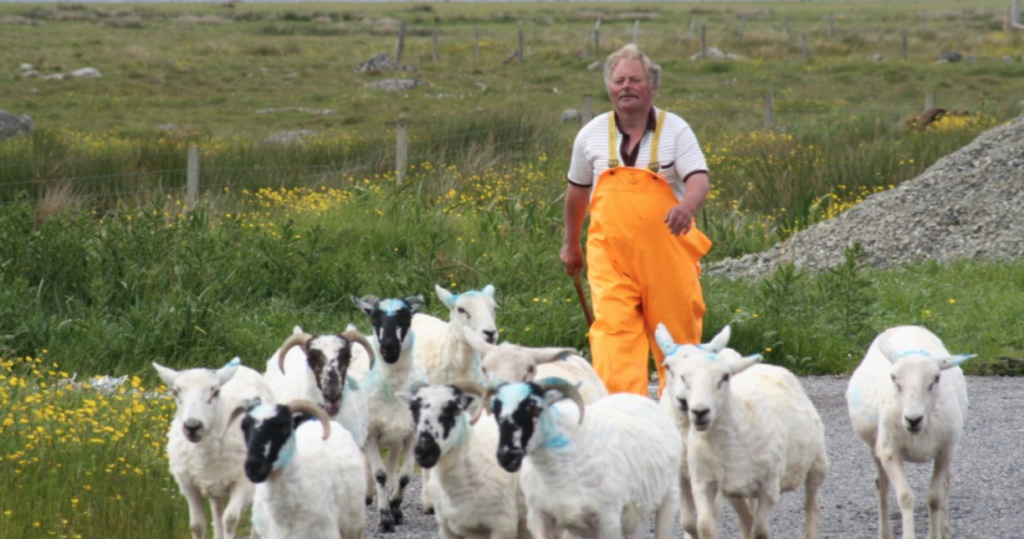
The Agrarian Trust is just one of many organizations across the world dedicated to the advancement of community control of the land. In Scotland, state-level land reform and grassroots organizing have led to the widespread practice of community land ownership. In 2010, Community Land Scotland (CLS) was founded to act as a shared voice for community landowners in Scotland and to provide support for communities as they navigate the complex world of purchasing and managing land as a community body. Today, its members “manage 560,000 acres of land, home to some 25,000 people.” As models like the Agrarian Commons gain traction in the United States, it is worth studying the examples of our global partners. CLS deploys a compelling mix of policy work, training, and networking opportunities to support community land ownership in Scotland.
Scotland has a long history of communal land ownership. Before the mid-18th century, farmers living in the Scottish highlands practiced a form of land tenure known as the run rig system. Arable land was periodically redistributed between farmers to ensure no one individual could monopolize the best land, while inferior land was used as common pasture for grazing livestock. After much of the arable land was enclosed for commercial sheep farming during a period known as the Highland Clearance (1780–1890), small-scale farmers were forced to become tenants on inferior pieces of land.
According to Magnus Davidson, board member of CLS and research associate with the University of the Highlands and Island’s Environmental Research Institute, the history of land grabbing in Scotland is closely tied with the violent history of Western imperialism and slavery. Davidson explained, “with profits from the slave trade came many rich industrialists buying land in the highlands, concentrating the land, creating this inequality.” Scottish land is still concentrated in the hands of a tiny portion of the Scottish population. “Very few people,” said Davidson, “usually rich white men, own very large parts of Scotland, and usually in very large land holdings.”
The history of land grabbing in Scotland is closely tied with the violent history of Western imperialism and slavery.
Very few is almost an understatement. Today, “half of the country’s privately owned land is held by just 432 owners” while “a mere 16 owners hold 10% of Scotland.” The largest landowners include members of the Scottish nobility, government land trusts, and private owners. Because the UK is still a monarchy (feudalism was only abolished in Scotland in 2000), many of these landowners are members of the nobility who have owned their properties for over 400 years.
According to Davidson, the concentration of land ownership has had a corrosive effect on rural communities in Scotland, including the historic depopulation of much of the Scottish countryside. While 98 percent of Scottish land mass is considered rural by the Scottish government, only 17 percent of the Scottish population live in rural areas, according to a 2019 government report. Davidson ascribes this demographic pattern to historical factors such as the Highland Clearances, and to young people seeking better opportunities in urban centers, as well as the housing shortage facing rural Scotland.
Scottish farmers and rural communities also face extremely high land prices, which have been driven up by the growing trend among wealthy individuals of purchasing second homes in the countryside, along with a relatively recent phenomenon known as Green Capitalism.
“With increasing carbon markets,” Davidson explained “you can restore peats, you can restore bogs, you can plant trees and allow native regeneration, and get paid for the carbon that you’re then sequestering. So at the moment, we have a huge amount of wealthy individuals, huge pension funds, who are all interested in carbon sequestration and getting to net zero, who are coming in and buying all the land that they can get to plant trees, to rewild, to restore nature.”
The Dutch billionaire, Anders Holch Povlsen, for example, has purchased more than 200,000 acres of Scottish land, with the intention of “rewilding” the land. While carbon sequestration is an important part of building climate resilience, these profit-motivated land purchases have caused prices to increase dramatically, making land, housing, and other vital needs increasingly inaccessible to rural residents of Scotland. In response to historic injustices and the high cost of land, communities and grassroots organizations around Scotland, including CLS, are uniting to envision a transformed countryside, rooted in community, rather than private, ownership of the land.
Community land ownership allows people to reclaim Scottish land from large landowners, and to manage it with their own.
With community land ownership, said Davidson, “profits aren’t being extracted, land isn’t being used in a specific way for the owner. It’s used for the benefit of the community, who are arguably at times better custodians of the land because it’s their land.” Community land ownership allows people to reclaim Scottish land from large landowners, and to manage it with their own, rather than absentee landlords’ interest in mind. Today, CLS deploys a combination of policy work, networking, and training to support community landowners and communities interested in purchasing land.
In 2003, the Scottish Parliament passed the Land Reform Act, an important piece of legislation which made community land ownership a widespread reality. Communities with populations under 10,000 gained the “community right to buy”, or the right to register an interest in and communally purchase land when it comes up for sale. While the majority of community-owned land is purchased without the use of the community right to buy, such legislation makes it possible for communities to purchase land from private sellers who might not otherwise consider community buy-outs.
Campaigning for policy reform like the Land Reform Act is a central feature of CLS’s strategic approach. “Lobbying is a way of looking after your membership, and future members, and advancing the cause of community land ownership, which can have such a transformational impact,” Davidson explained. In the policy paper, Land for the Common Good Community Land Scotland’s Manifesto for a Sustainable Scotland, CLS lays out its policy priorities, including, but not limited to, “Controlling land monopolies to protect the public interest,” “Empowering communities to build local resilience,” and “Tackling the climate emergency while ensuring a just transition to net zero carbon emissions.”
CLS also provides a range of services for its members, including training programs and networking opportunities for community landowners and prospective buyers. “Not all of our members are community owners,” said Davidson, “but they could be interested in community purchases, so we help them through the process of buying land and buying assets at the same time too, so if you’re a community thinking about purchasing land, you can come to us and we can walk you and talk you through the process from thinking about right through to post acquisition.”
So far, CLS has seen impressive results in both rural and urban regions, as community owners leverage their ownership to develop renewable energy, affordable housing, and wilderness reserves, among numerous other initiatives. In Glasgow, CLS supported member organization Spire View Housing Association in purchasing a church for use as a much-needed community center. CLS has also supported efforts to construct affordable housing in rural areas affected by depopulation and housing prices driven upwards by absentee ownership. On the Isle of Gigha, a local community land trust invested in renewable energy, installing wind turbines whose profits the trust plans to redirect into building housing and stimulating the region’s local economy.
The community land ownership model provides a clear path forward.
For Davidson and many others, the community land ownership model provides a clear path forward. Where large landowners seek to concentrate their power even as they adopt the language of environmentalism, CLT shows us the real possibility of a just, equitable and community-oriented relationship with the land.
“My family were cleared from all across this area we live in, my partner’s family were cleared from all across this area we live in,” Davidson told me. “So I go and walk in the places where our families were cleared from, where nobody lives anymore and I think we could be building new houses here, new schools here, my daughter could live here, and my step kids could be living here in the future.”


